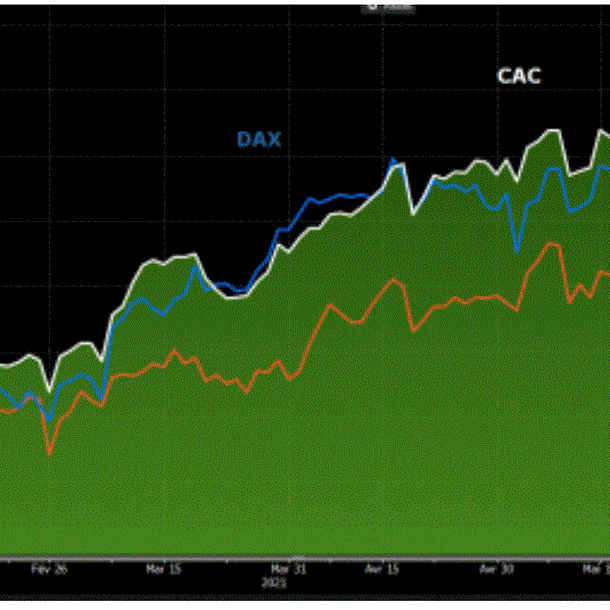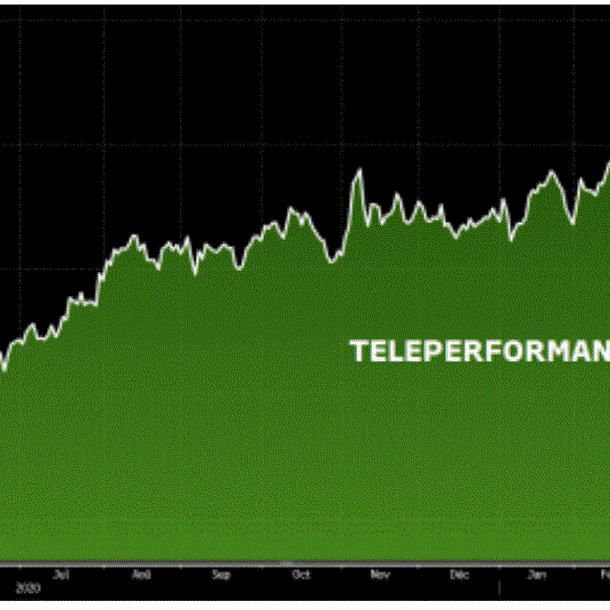|
Monday June 28 | Weekly market update |
 |
After a few sessions of drops due to fears that the Fed would tighten monetary policy sooner than expected, financial markets rallied in the past five sessions. Central bankers once again reaffirmed their support, insisting that inflationary pressures would be transitory. Wall Street took advantage of this to set new records, while in Europe, indexes are returning close to their recent highs. Traders are taking advantage of each downturn to quickly return to buying, with the prospect of a continuation of the current economic expansion. |
| Indexes Over the past week, Asia has been recovering. The Hang Seng gained 1.8%, the Shanghai composite 2.3% but the Nikkei recorded a weekly performance of only 0.3%. In Europe, green dominates. The CAC40 recovered 0.8%, the Dax also gained 0.8% and the Footsie 1.6%. Regarding the peripheral countries of the euro zone, Spain and Portugal are somewhat behind, with gains of only 0.5% and 0.2% while Italy is up 0.9%. In the US, the Nasdaq100 and S&P500 continued their record-breaking run, with gains of 2.3 and 2.7%. The Dow Jones is still 2% off its previous highs from May 10, but is up 3.3% over the past five days. Comparison of the CAC40, DAX and FTSE100  |
| Commodities It is time for consolidation on oil markets, which are catching their breath after a long and powerful bullish rally. The US benchmark is trading at its highest level of the year, above USD 73, as is Brent at USD 75 per barrel. It seems that the bullish fuel is running out to carry prices higher. As a result, traders are limiting their moves as they await the next OPEC+ meeting on Thursday to decide on production levels. Precious metals are regaining some height. The gold metal is struggling to regain positive momentum despite an easing in US 10-year real rates and is trading around USD 1,785 per ounce. The base metals segment had a bullish week, despite China's attempts to mitigate the upward pressure on prices. Beijing did decide to sell off some of its strategic reserves in order to control price inflation, but this probably did not have the desired effect, as markets were expecting much more drastic measures. Copper is trading near USD 9,300. In agricultural commodities, corn, which is trading at USD 653 per bushel in Chicago, is back on the upswing as China's appetite for imports increases significantly. On the other hand, lumber is on a new week of decline, as supply is quickly adjusting to demand. Timber over 1 sliding year  |
| Equity markets Téléperformance, the world leader in call centers and business services recently celebrated its first anniversary in French indice CAC40. In June 2020, Sodexo had given up its position after suffering a 25% drop since the beginning of the year, due to the crisis. Over the same period, Téléperformance gained 45%. During the week, the French company announced the completion of the acquisition of Health Advocate, a US company that specializes in digital solutions for the healthcare sector. Investors were satisfied with the acquisition of this leader in online health platforms. A progression that brings the share to historical highs. With a market capitalization of 20 billion euros, the Téléperformance share gained almost 7% over the week. The company, which generates half of its revenue in the United States, outsources customer service for many multinationals. Since 2017, the company has seen an average annual revenue growth of 11%. In 5 years, the share price has increased fivefold. A growth that pays off, the stock is trading at nearly 40 times the company's profits. Téléperformance's share price since January 2020  |
| Bond market Not much happened on the interest rate market this week, at least on the 10-year maturity of US debt, which remained stuck at 1.5%. This situation is all the more surprising given that the equity markets experienced small bouts of nervousness after the US central bank changed its stance. Some economists speak of technical factors to explain this situation, but also of more fundamental elements such as the fact that more investors now subscribe to the scenario of a transitional inflation that would allow the Fed to continue to benefit from a correct margin of maneuver. Shorter maturities reacted more positively. The Bund yield has risen a bit but remains in negative territory at 0.18%. Italian debt is back at 0.90%, more than twice the level of Spain or Portugal (0.44%). |
| Foreign exchange market The euro rallied a bit against the dollar to USD 1.1939, after breaking the USD 1.19 threshold after the Fed meeting last week. Good European data, both in the German Ifo and June flash PMI indicators, fueled the rise, but failed to lift the single currency above USD 1.1950. The British pound lost ground against the euro last week, at GBP 0.858 per EUR, as the Bank of England, while acknowledging a stronger British economy, gave no signs of tightening monetary policy. Earlier signals suggested that the central bank was going to be a little firmer. A few words on the Mexican peso, which gained ground against the dollar after the Bank of Mexico decided to raise its key interest rate from 4 to 4.25%, in an attempt to counter inflation of 6%, well above the upper limit that the BoM is willing to grant itself, even on a transitory basis (i.e. 4%). The USD is trading at MXN 19.811. |
| Economic calendar Few figures were on the agenda in the euro zone last week. The manufacturing and services PMI indexes exceeded expectations, at 58 and 63.1 respectively. They came in at 64.9 and 58.1 in Germany but missed the consensus in France, at 58.6 and 57.4. Also for Germany, the Ifo index recovered to 101.8 (consensus 100.8 and 99.2 previously). In the United States, apart from the Flash PMI manufacturing index which accelerated to 62.6, the other figures were worse than expected. The Services PMI fell to 64.8 (70.4 previously), New Home Sales fell to 769K, Durable Goods Orders rose by only 2.3%, and Weekly Unemployment Claims came in at 411K, slightly below last week's numbers. In the latest estimate, the US GDP for the first quarter is nevertheless in line with expectations, up by 6.4%. |
| Towards the end of asset buybacks? With helicopter money expected to end in the US by September, traders are starting to anticipate the beginning of the end of asset purchases. This would be forgetting that the FED is taking its time and preparing markets for a gradual reduction in its support measures for the economy. Indexes are still taking advantage of the end of June to gain a few more percent. We will have to wait until the middle of this week to benefit from the major economic statistics on U.S. employment for June. The FED could adjust its accommodative policy to these data. In the meantime, slow and steady wins the race. |

 By
By 










